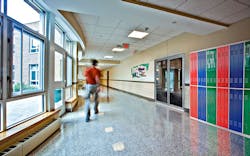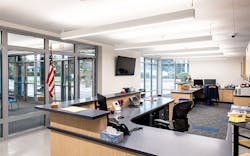School Safety is In the Making
Children and young adults spend the vast majority of their waking hours in or around their schools. Over the past 40 years, building and design professionals have studied how the built environment can help improve student retention rates, learning outcomes and psychological wellness.
But these are not the only worries students, teachers and parents have when it comes to school building design. Unfortunately, on-campus violence, including active shooters, is a growing concern. Many schools have taken measures to keep students safer, such as adding security guards, surveillance systems, metal detectors and more. However, there are ways to enhance the level of protection these measures provide—including improving safe school design.
So how can schools be made safer? How can the building industry come together to protect kids?
Multifunctional, fire-rated and security glazing contributes to safer school building design
One increasingly common method for raising the baseline of security through design is to incorporate forced-entry or bullet-resistant glazing in entry vestibules, classroom doors and other areas designated to protect students and staff. While an effective measure, it is important to note the need for enhanced security in schools does not remove the requirement to meet fire-and life-safety codes—especially given the National Fire Protection Association estimates there are an average of over 3,000 fires on school campuses annually. Building and design teams must address all criteria to ensure the application will perform as intended when needed—no matter what the threat is.
However, creating multifunctional, fire-rated assemblies is not as simple as combining two rated components into one assembly. For example, many forced-entry and bullet-resistant materials (such as films) are plastic-based, and so can burn quickly and intensely. As such, they could potentially offset the system’s fire rating. For a system to provide the level of protection its parts were tested to, it is important that a multifunctional, fire-rated glazing assembly uses components that are known to be compatible (from the frames and glass to the component parts). Such systems ensure one form of protection is not compromised for another. As a result, they can provide critical protection regardless of the threat. They can stand strong during a security breach or defend against flames, smoke and heat during a fire event.
For example, Technical Glass Products’ assemblies that use Pilkington Pyrostop® laminated to School Guard Glass® meets HP White 5-aa10, ASTM E2395, ASTM F1233 and can provide UL bullet-resistance ratings up to Level III. Likewise, because these systems can use large lites of transparent glazing within narrow-profile frames, they can contribute to visual connectivity and access to natural light. On the one hand, this helps schools create a welcoming and open environment for students. On the other, it can work with other surveillance and access control systems to provide warning of approaching life-safety threats. This helps create multiple layers of protection—a best-practice recommendation from the Partner Alliance for Safer Schools (PASS) guidelines for K-12 schools.
An elementary school in Oregon used this type of system to meet stringent fire codes while providing a crucial layer of security in an entry vestibule during the school’s 2020 renovation. While the school’s use focused on hardening its exterior, multifunctional, fire-rated glazing can be specified throughout a building to create more layers of security and safeguard paths of egress for evacuation.
Are voluntary security practices enough?
As the Oregon elementary school example shows, multifunctional, fire-rated glazing assemblies can help schools bolster the safety and security their buildings offer. It can also be incorporated throughout the built environment to add layers of security for a safer school building design.
That said, currently most schools that incorporate multifunctional, fire-rated glazing assemblies do so at their own discretion as it is not required by building codes—though this may change as more states begin calling for higher security standards on school campuses.
The question then becomes how can we in the building industry work together to ensure the safety of students and teachers?



